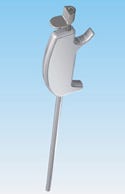Surgical Scope Spots Tissue Damage to Bones and Cartilage
July 1, 2008
R&D DIGEST
|
Kunle Oloyede led the development of the smarthroscope and hopes that the device will lower surgical costs and have use in developing nations. |
A device similar to an arthroscope is designed to help doctors assess damage to tissue caused by osteoarthritis and other bone and cartilage ailments. Named the smarthroscope, the device has potential to be used in operating rooms and clinics around the world, even in remote areas where doctors may not have specific training in joint-tissue defects or have access to other technologies. It could also aid in researching joints and evaluating the success of current and emerging treatments.
“It is not a diagnostic tool, but instead is an aid for decision making during surgery,” says Kunle Oloyede, PhD, of the Queensland University of Technology (QUT; Brisbane, Australia). “It tells the surgeon what is wrong with cartilage and bone, to what extent, and why. Therefore, the smarthroscope could remove surgical subjectivity and help less-experienced surgeons in their work.”
|
The smarthroscope could give doctors an inside look at tissues, and provide a more accurate evaluation of joint defects. |
“It looks like an arthroscope, and it can be applied in a similar way through keyholes,” says Oloyede, a professor at QUT's School of Engineering Systems. “However, its mode of operation is not based on video but on measurements of parameters that characterize joint tissues. Its output is also very different; in its final form this device may be smaller than a conventional arthroscope.”
Oloyede, who led the work on the device, says the scope could provide a better image of what's happening inside of the tissue. Having the ability to accurately evaluate a focal area of a joint defect would help doctors establish how much tissue should be removed in the case of replacement surgery. The scope also could help them prepare an area for a therapy such as a cell-based procedure.
Advantages to the smarthroscope include lowering the cost of procedures and eliminating surgery in cases in which it's deemed unnecessary. It could also provide guidance to doctors in developing countries who might not have much experience in joint-tissue treatment or access to state-of-the-art technology.
The researchers conducted their work at QUT's Institute of Health and Biomedical Innovation. They plan to reduce the size of the device as much as possible, after which they will apply its use to tissues. Results of real-world testing will be used to refine the scope. Once these goals are reached, the team will seek commercialization. The preliminary device mock-up could be ready by the middle of next year, followed by a prototype in as soon as three years.
Copyright ©2008 Medical Device & Diagnostic Industry
About the Author(s)
You May Also Like



.png?width=300&auto=webp&quality=80&disable=upscale)
